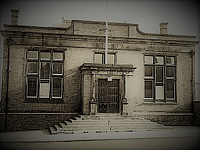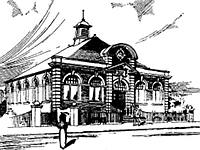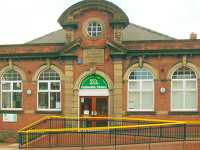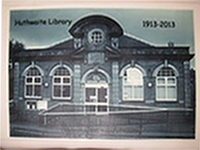Library Background
Nearest recorded library had been established in the larger village of Sutton-in-Ashfield way back in 1842, when accommodated in the Market Place house of Mr Charles Stones. No records were ever found to reveal its designed usage. Such early dating only suggests a privately stocked reading club, most likely offering a wider selection of newly circulating newspapers for a few privileged members who shared educated influence covering parish township developments. A similar loss of Select Vestry Minutes also frustrated historian research into the steps made by earliest form of Local Government.
From dark depths of an industrial revolution came many mid 19th century social reforms to liberally improve working conditions, public health and education. The 1845 Museums Act introduced opportunity for larger boroughs to provide Free library access. Because it required using part of an existing public building, this only managed to raise limited interest in a few larger towns affording higher cultural significance. A Public Libraries Act of 1850 took a bigger leap forward by offering smallest authorities the ratable opportunity of establishing their own book loaning services. This ideal founded basis for the current Free Public Library system. Amended 1853 to extend coverage across the entire UK, it would eventually recognise a community library among the heart of most towns and villages.
While books were still relatively expensive, and workers gained some free time, so often idly spent in the numerous public houses, a local library was being seen as a positive way to promote mindful recreation and improve education to the benefit of its locality. This meritable principle did not find much immediate response, judged by so few new buildings or services being only very slowly established. Cost would always be a significant factor, especially among smaller or poorer areas. Employment and public health would be higher priority, while bearing in mind the uneducated majority of the general population could barely yet read. It is somewhat commendable therefore, in finding our Sutton parish can claim a well used public library room dating back from 1857.
Sutton Public Library

Principal founder of an 1857 Sutton Rural Library and Newsroom was a Mr H. Columbine. Premises in which this first public library became established stood on Parliament Street, formerly known as Thorney Croft. An external flight of steps gave access to a requisitioned upper room. That not only modestly sufficed for nearly three decades, but also doubled up as a school room under instruction of Sutton's first village postman Mr Tom Dove.
Ground floor added some related interest becoming the printing office for Mr L. Lindley. His 1907 publication records a little more historical detailing for further referencing. Throughout latter few years, librarians commanded two upper rooms above old council offices in the Market Place. An opportunity to relocate the above library into more spacious accommodation seems to have arisen as a result of rapid progressions made under a newer Local Government.
An 1858 Act introduced greater powers for local authorities who adopted an elected Local Board. This large village adopted that Act in 1865 with a 13 December election. From thenceforth, Sutton Urban District Councillors began asserting higher town status by introducing progressive advancements.
Schooling would have gained higher priority before private philanthropists really started encouraging construction and provision of Free Public Libraries throughout the late 1880s. Nonetheless, it was Queen Victoria's Golden Jubilee year which became the catalyst for widespread building. And this was exactly how our Town of Sutton decided to commemorate that historic 1887 royal occasion, having partaken in those national celebrations on June 21st.
Free Public Library

Land upon which to build this library was given by His Grace the Duke of Portland, sited upon Forest Street, facing the High Pavement junction. The architect was Mr. J. P. Adlington, of Sutton.
Biggest room used for public reading measured 35ft by 25ft 6ins. All beneath an airy 14ft ceiling, going down in size was a lending library, a ladies room, stores and lavatories.
Defrayed cost around £2,500 came by way of public subscription and the Dukes generosity. It was then opened in May 1888 by the Duchess of Portland.
Local historian Mr G.G. Bonser was one who gifted valuable works, among upward 1,200 book volumes being made available for circulation. This institution was maintained by a 1d. rate, affording the librarian Mr C. G. Burton a yearly salary of £52.
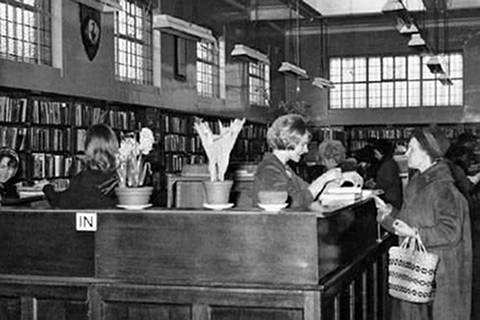






Sutton Living Memory Group members shared numerous photos and still have many fond memories of their historic building. A few choice examples may also help reveal its past location, the site having since been replaced by Halfords.
Huthwaite could claim an undistinguished reading room was earlier allocated within some small house. But an 1893 opening of a New Hucknall Colliery Institute afforded this growing mining community its first recognisable designated reading room. That did not however, offer the general public a book loaning service, which Sutton did fulfil.
Huthwaite opened its own Carnegie funded library in 1913. Some proudly claimed it even managed to trump the Sutton amenity in both design and size, which would be a first. Nonetheless, its history is fully covered via the pictorial menu below each page.
A vastly superior premises, more befitting one of the largest towns in Nottinghamshire, would be found integrated within a new open air retail precinct. Clearing away some of the old Sutton slum housing paved way for building the Idlewells Shopping Centre, and 1971 opening revealed prominent position for today's Free Public Library above main entrance. The titled County Library reflects earlier higher adoption of services, promoting Sutton into housing a wealth of historic material to begin any local research.



08 Feb 18 by Gary Elliott Updated 08 Dec 18

